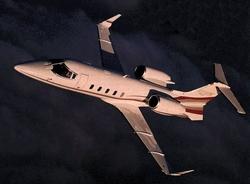Move Follows Findings In South Carolina Lear Accident
 The NTSB has made a series of recommendations to the FAA
following its findings in an accident in South Carolina in which
tires were deemed to be a contributing factor.
The NTSB has made a series of recommendations to the FAA
following its findings in an accident in South Carolina in which
tires were deemed to be a contributing factor.
The board recommends that the FAA provide pilots and maintenance
personnel with information that:
- Transport-category aircraft tires can lose up to 5 percent
pressure per day.
- It may take only a few days for such tires to reach an
underinflation level below what the aircraft maintenance manual
specifies for tire replacement.
- The underinflation level that would require tire replacement is
not visually detectable.
In addition, the board says the FAA should require that all 14
Code of Federal Regulations Part 121, 135, and 91 subpart K
operators perform tire pressure checks at a frequency that will
ensure that the tires remain inflated to within aircraft
maintenance manual-specified inflation pressures, require that
aircraft maintenance manuals specify, in a readily identifiable and
standardized location, required maintenance intervals for tire
pressure checks (as applicable to each aircraft), and allow pilots
to perform tire pressure checks on aircraft, regardless of whether
the aircraft is operating under 14 Code of Federal Regulations Part
91, Part 91 subpart K, or Part 135.
It is also calling for tire pressure monitoring systems for all
transport- category airplanes.
 As relates to the specific accident, the NTSB has recommended
that the FAA identify deficiencies in Learjet's system safety
analyses, both for the original Learjet 60 design and for the
modifications after the 2001 accident, that failed to properly
address the thrust reverser system design flaws related to this
accident, and require Learjet to perform a system safety assessment
in accordance with 14 Code of Federal Regulations 25.1309 for all
other systems that also rely on air-ground signal integrity and
ensure that hazards resulting from a loss of signal integrity are
appropriately mitigated to fully comply with this regulation.
As relates to the specific accident, the NTSB has recommended
that the FAA identify deficiencies in Learjet's system safety
analyses, both for the original Learjet 60 design and for the
modifications after the 2001 accident, that failed to properly
address the thrust reverser system design flaws related to this
accident, and require Learjet to perform a system safety assessment
in accordance with 14 Code of Federal Regulations 25.1309 for all
other systems that also rely on air-ground signal integrity and
ensure that hazards resulting from a loss of signal integrity are
appropriately mitigated to fully comply with this regulation.
It further recommends that the Agency revise available safety
assessment guidance (such as Advisory Circular 25.1309-1A) for
manufacturers to adequately address the deficiencies identified in
Safety Recommendation A-10-51, require that designated engineering
representatives and their FAA mentors are trained on this
methodology, and modify FAA design oversight procedures to ensure
that manufacturers are performing system safety analyses for all
new or modified designs that effectively identify and properly
mitigate hazards for all phases of flight, including foreseeable
events during those phases (such as a rejected takeoff). The board
says that tire testing criteria should reflect the actual static
and dynamic loads that may be imposed on tires both during normal
operating conditions and after the loss of one tire and consider
less-than-optimal allowable tire conditions, including, but not
limited to, the full range of allowable operating pressures and
acceptable tread wear.
And finally the NTSB says the FAA should require that pilots who
fly in 14 Code of Federal Regulations (CFR) Part 135 operations in
an aircraft that requires a type rating gain a minimum level of
flight time in that aircraft type, similar to that described in 14
CFR 121.434, taking into consideration the unique characteristics
of Part 135 operations, to obtain consolidation of knowledge and
skills.
 ANN's Daily Aero-Term (04.25.24): Airport Rotating Beacon
ANN's Daily Aero-Term (04.25.24): Airport Rotating Beacon ANN's Daily Aero-Linx (04.25.24)
ANN's Daily Aero-Linx (04.25.24) Klyde Morris (04.22.24)
Klyde Morris (04.22.24) Airborne 04.24.24: INTEGRAL E, Elixir USA, M700 RVSM
Airborne 04.24.24: INTEGRAL E, Elixir USA, M700 RVSM Airborne 04.22.24: Rotor X Worsens, Airport Fees 4 FNB?, USMC Drone Pilot
Airborne 04.22.24: Rotor X Worsens, Airport Fees 4 FNB?, USMC Drone Pilot




